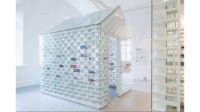May 2022 Editor's Letter: The Post-Pandemic Workplace
Back to the Drawing Board

Cathleen McGuigan, editor-in-chief of Architectural Record. Photo © Jenna-Beth Lyde
If you are going back to in-person work at a tech company these days, you may be greeted by bands, balloons, and beer blasts, according to a recent article in The New York Times. And you could well see your old office with a new post-pandemic look. As companies increasingly operate under a hybrid model, with employees continuing to work from home as well as the office, making the workplace more alluring, comfortable and flexible is a key design strategy, as we explore in this issue of RECORD.
As RECORD has often noted, architecture of offices began to change radically in the digital age, long before Covid, with an emphasis on collaborative spaces and amenities—and shrinking individual workstations. Besides the goals of the tech industry, which sought to keep staff laboring for long hours with the lure of free food, foosball, and on-site dry cleaners, the realities of real-estate costs also pushed further change. Those luxurious but often empty corner offices of CEOs, who spent most of their time traveling or in meetings, became a target of budget-cutting. Smaller and smaller cubicles gave way to shared benchlike desks, where an individual spot was measured in inches, not feet. And hoteling became ever more prevalent, with no designated desks at all.
As employees return to offices across many professions, those same trends are evolving in the design of the new workplace. One leading source of inspiration for architects is the hospitality industry—which has prompted the proliferation of plush office lobbies filled with sofas, plantings, and cafés, for informal meetings or solo work. A demand for social distancing is preventing many offices from shrinking, despite fewer staff members’ coming in each day—crammed worktables are out, and flexible areas, with reconfigurable, wheeled furnishings are in. And outdoor space, if available, has become a major amenity, not only for coffee breaks, but for actual work, with balconies, terraces, and adjacent alleys provided with Wi-Fi, shade canopies, and even fire pits. Fresh air (note SHoP’s facade for the Uber headquarters in San Francisco featured on RECORD’s May 2022 cover) and daylight remain major worker health benefits.
As architects develop new workplaces for clients, they are also revisiting their own employee protocols and office design. A random sampling of firms indicates that they are back in person, but many are also allowing staff to work from home some days of the week. Whether this is just a transition period is not yet clear, but, for those using a hybrid model, the norm tends to be a minimum of three days a week in the office.
SOM in New York was about to move into its newly designed 69,000-square-foot office—on two floors of 7 World Trade Center, a building the firm designed and completed in 2006—when Covid struck. But now that the team is finally ensconced in its new space, the design turns out to have anticipated a number of post-pandemic trends, as Chris Cooper, the partner in charge of the project, tells RECORD. While employees have assigned workstations, they can easily carry laptops to the extensive flexible areas around the office for collaborative work. Technology is key, with large screens not only in conference rooms, but also around the office, so people can engage even while in the café. The current attendance policy for SOM (which was planning to introduce remote work even before the pandemic) is called “2-2-2”: staffers can work from home two days a week; shift their daily schedule for up two hours; and work two weeks a year from home.
For the global giant Gensler, remote connection has long been integral to its work. But the firm is updating its conference capacity in several of its U.S. offices, experimenting with advanced video technology to create a greater sense of inclusion for each participant, no matter the distance. Yet designing workspaces is in Gensler’s roots and extends to their own offices, which a spokeswoman calls “living laboratories,” so in-person, collaborative environments remain part of firm culture.
As they do for most practices. Architecture is, after all, a team sport, as the cliché goes. And while work styles may shift, architects tend to be social; they like to meet face to face, and working in person, in the office, is not going away, even as workplace design changes to meet new demands. Architecture firms are not offering rock concerts and party favors to draw most staff back to the office. But beer or wine? Sure.



